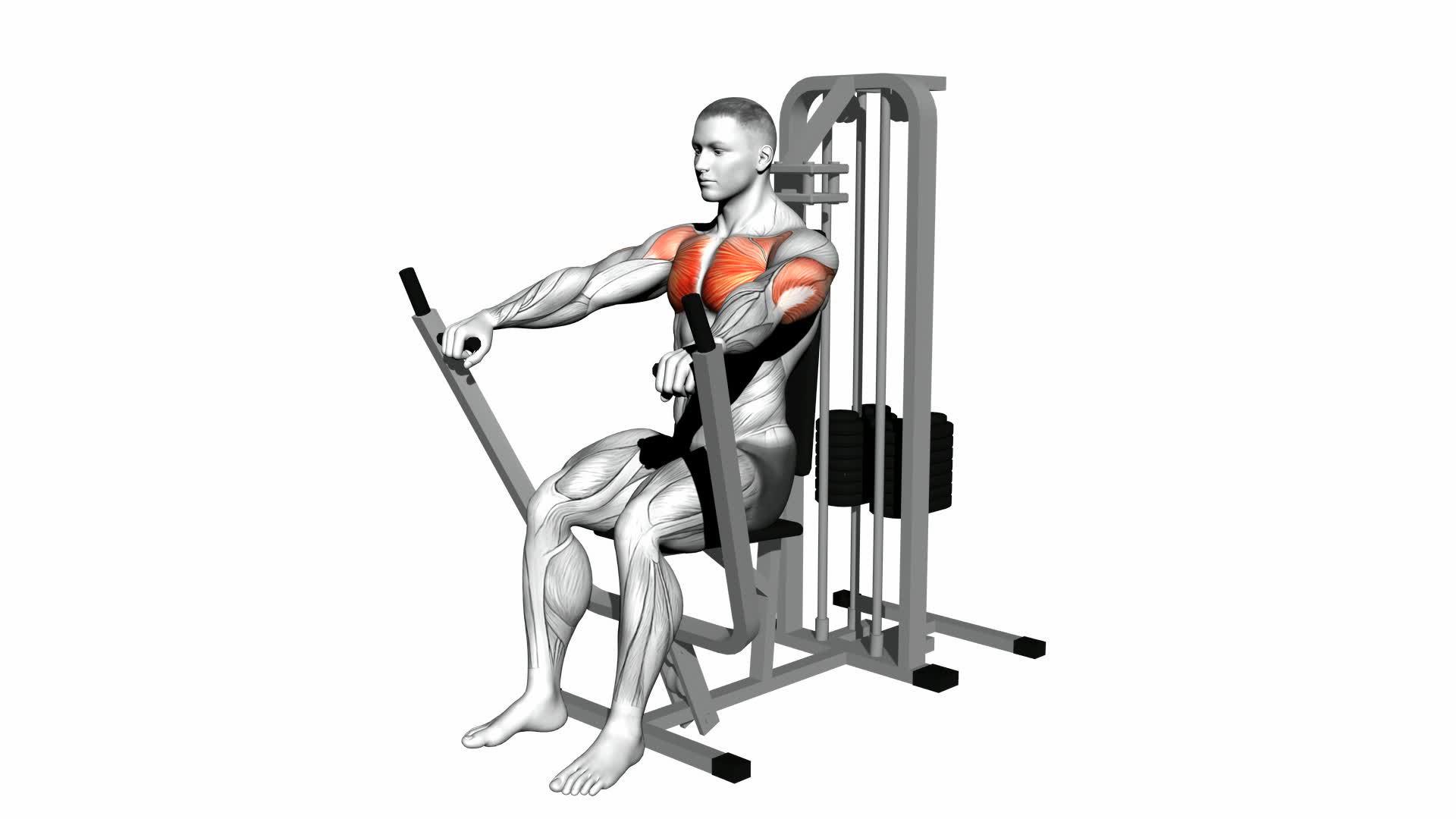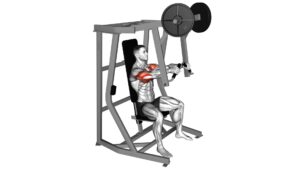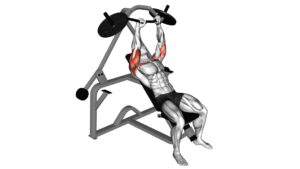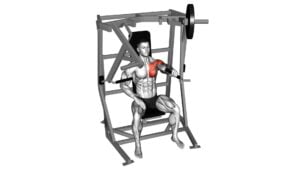Lever Chest Press – Video Exercise Guide & Tips

Are you looking to strengthen your chest muscles? The Lever Chest Press is the perfect exercise for you! In this video exercise guide, we'll show you the proper form and technique to get the most out of this exercise.
Watch This Exercise Video
We'll also provide tips on the recommended weight and repetitions, as well as common mistakes to avoid. With variations and modifications, you can customize this exercise to your fitness level.
Get ready to maximize your chest workout!
Key Takeaways
- The lever chest press improves upper body strength and targets the pectoralis major muscles, triceps, deltoids, and serratus anterior muscles.
- Proper form and technique are crucial to avoid common mistakes such as arching the back or using momentum. It is important to maintain proper body alignment, use a weight that allows for proper form, and avoid jerking or bouncing the weight.
- Body alignment is essential for optimal muscle activation and efficient movement. Good posture, with feet shoulder-width apart, knees slightly bent, back straight, and chest lifted, helps distribute the load evenly and reduce strain on specific muscle groups or joints.
- Gradually increasing weight, listening to the body, and adjusting weight and repetitions accordingly are key to progress and avoid injuries. It is important to avoid common mistakes such as arching the back excessively, overloading the weights beyond capabilities, not keeping elbows aligned with shoulders, bouncing the weight off the chest, and failing to engage the core.
Benefits of the Lever Chest Press
The lever chest press offers a variety of benefits for your upper body strength and muscular development. By incorporating this exercise into your workout routine, you can effectively improve muscle strength and increase chest muscle definition. The lever chest press specifically targets the pectoralis major muscles, which are the main muscles responsible for the size and shape of your chest. This exercise also engages the triceps, deltoids, and serratus anterior muscles, providing a comprehensive upper body workout.
One of the key benefits of the lever chest press is its ability to target and isolate the chest muscles, allowing for focused development and increased muscle activation. Additionally, this exercise allows for a greater range of motion compared to other chest exercises, which in turn leads to greater muscle stimulation and growth.
Furthermore, the lever chest press is a safe and effective alternative to traditional barbell or dumbbell chest presses, as it provides a more stable and controlled movement. This reduces the risk of injury and allows for proper form and technique.
Proper Form and Technique
To ensure you perform the lever chest press correctly, it's important to avoid common mistakes and focus on body alignment. By avoiding mistakes such as arching your back or using momentum, you can maximize the effectiveness of the exercise and reduce the risk of injury.
Additionally, maintaining proper body alignment, including a stable core and engaged muscles, will help you target the chest muscles more effectively and get the most out of your workout.
Avoiding Common Mistakes
To avoid common mistakes while performing the lever chest press, make sure that you maintain proper form and technique. One common mistake is using too much weight, which can lead to poor form and increase the risk of injury. It's important to start with a weight that allows you to perform the exercise with proper form.
Another mistake to avoid is arching your back or lifting your hips off the bench. This can put unnecessary strain on your lower back. Instead, keep your back flat against the bench and maintain a stable position throughout the exercise.
Lastly, make sure to use controlled movements and avoid jerking or bouncing the weight. This will ensure that you target the chest muscles effectively and reduce the risk of strain or injury.
Importance of Body Alignment
Maintain proper body alignment, form, and technique during the lever chest press to maximize effectiveness and minimize the risk of injury.
Proper body alignment is essential for optimal muscle activation and efficient movement during this exercise. By maintaining good posture, you ensure that your muscles are working in the intended manner, leading to better results.
Additionally, correct body mechanics help distribute the load evenly, reducing strain on specific muscle groups or joints. To achieve proper alignment, start by positioning your feet shoulder-width apart, with your knees slightly bent. Keep your back straight and chest lifted throughout the movement.
Engage your core muscles to stabilize your spine. By focusing on body alignment and using proper form and technique, you can perform the lever chest press more effectively and minimize the risk of injury.
Recommended Weight and Repetitions
Select a weight that challenges you without compromising proper form and aim for a specific number of repetitions based on your fitness level. It's important to find the right balance between pushing yourself and maintaining good technique.
Here are some tips to help you determine the recommended weight and repetitions for the lever chest press:
- Start with a weight that allows you to perform 8-12 repetitions with proper form. This range is generally considered optimal for building strength and muscle.
- If you can easily do more than 12 repetitions, increase the weight to make it more challenging.
- On the other hand, if you struggle to complete 8 repetitions with proper form, decrease the weight to avoid compromising your technique.
- As you progress and become stronger, gradually increase the weight to continue challenging your muscles.
- It's important to listen to your body and adjust the weight and repetitions accordingly. Don't be afraid to modify based on how you feel during the exercise.
Common Mistakes to Avoid
When performing the lever chest press, it's crucial to avoid common mistakes that can negatively impact your form and increase the risk of injury.
Incorrect form, such as arching your back or flaring your elbows, can strain your muscles and joints.
Additionally, overloading the weights beyond your capabilities can lead to muscle imbalances and potential accidents.
Incorrect Form Dangers
To avoid potential injuries, be mindful of your form while performing the lever chest press exercise. Incorrect form can lead to various dangers and increase the risk of injury. Here are some common mistakes to avoid:
- Arching your back excessively can strain your lower back and lead to pain or injury.
- Using too much weight can cause loss of control and put excessive strain on your joints.
- Not keeping your elbows aligned with your shoulders can result in shoulder impingement or strain.
- Bouncing the weight off your chest instead of maintaining a controlled movement can lead to muscle strains or tears.
- Failing to engage your core and stabilize your body can increase the risk of losing balance or straining other muscles.
Overloading Weights Risks
To avoid potential injuries and ensure a safe workout, it's important to be aware of the risks of overloading weights while performing the lever chest press exercise. Overloading weights refers to using a weight that's too heavy for your current strength level or exceeding your body's capacity to handle the load. This can lead to strained muscles, sprained ligaments, and even fractures.
Overtraining risks and injury prevention should be at the forefront of your mind when engaging in this exercise. To avoid these risks, it's crucial to start with a weight that challenges you but still allows you to maintain proper form and control. Gradually increase the weight as your strength improves to minimize the chances of injury.
Variations and Modifications
For different levels of difficulty and targeted muscle groups, you can try various variations and modifications of the lever chest press exercise. Here are some options to consider:
- Equipment options: You can choose to use different types of equipment for the lever chest press, such as dumbbells, barbells, or resistance bands. Each option provides a slightly different feel and challenge to the exercise.
- Hand position variations: By changing your hand position on the lever, you can target different areas of your chest muscles. For example, a wide grip will emphasize the outer chest, while a narrow grip will target the inner chest.
- Incline or decline variations: Adjusting the angle of the bench can change the emphasis on your chest muscles. Incline lever chest press targets the upper chest, while decline lever chest press focuses on the lower chest.
- Unilateral or bilateral variations: Performing the lever chest press with one arm at a time (unilateral) can help improve balance and stability, while using both arms simultaneously (bilateral) allows for heavier weights and greater overall strength.
- Progressive overload techniques: To continue challenging your muscles and promoting growth, you can incorporate progressive overload techniques. This can be done by gradually increasing the weight, the number of sets and reps, or by slowing down the tempo of the exercise.
By exploring these variations and modifications, you can keep your chest workouts engaging and continue to make progress.
Now, let's move on to some tips for maximizing your chest workout.
Tips for Maximizing Your Chest Workout
Now let's focus on how you can maximize your chest workout to achieve the best results.
When it comes to maximizing gains and chest muscle activation, there are a few tips you should keep in mind.
Firstly, make sure to use a weight that challenges you. While it's important to maintain proper form, using a weight that's too light won't effectively stimulate your chest muscles. On the other hand, using a weight that's too heavy can lead to improper form and potential injury. Find a weight that allows you to perform each rep with proper technique, while still feeling the burn in your chest muscles.
Secondly, incorporate different variations of the chest exercises to target your muscles from different angles. This will help to engage different muscle fibers and promote overall chest development. For example, you can try incline chest presses, decline chest presses, or even push-ups with different hand positions.
Lastly, focus on mind-muscle connection. Visualize your chest muscles working and actively engage them throughout each rep. This will help to maximize the activation of your chest muscles and improve the effectiveness of your workout.
Frequently Asked Questions
Is the Lever Chest Press Suitable for Beginners?
Yes, the lever chest press is suitable for beginners.
It's a great exercise to build strength in your chest muscles.
To perform it correctly, make sure to maintain proper form and technique.
Keep your back flat against the bench, grip the handles firmly, and push the weight forward using your chest muscles.
Avoid common mistakes such as arching your back or using too much weight.
With practice and proper guidance, you'll master this exercise in no time.
Can the Lever Chest Press Help in Building Muscle Mass?
The lever chest press can definitely help in building muscle mass. By incorporating this exercise into your workout routine, you can experience numerous benefits.
The lever chest press targets your chest, shoulders, and triceps, promoting muscle growth in these areas. It also engages your core for stability.
Additionally, there are variations of the lever chest press that allow you to target different muscle groups and add variety to your workouts.
What Other Muscle Groups Are Targeted During the Lever Chest Press Exercise?
During the lever chest press exercise, several other muscle groups are targeted in addition to the chest. This includes the shoulders, triceps, and even the core muscles for stabilization.
Incorporating other exercises that focus on these muscle groups can enhance the overall benefits of the lever chest press. By engaging multiple muscle groups, you can improve your strength and build muscle mass more effectively.
Is It Necessary to Warm up Before Performing the Lever Chest Press?
Before performing the lever chest press, it's necessary to warm up. Warming up has several benefits, such as increasing blood flow to the muscles, improving flexibility, and reducing the risk of injury.
To effectively warm up before a workout, you can start with some light cardio exercises like jogging or jumping jacks. Then, you can perform dynamic stretches that target the muscles involved in the lever chest press, such as the chest, shoulders, and triceps.
Can the Lever Chest Press Be Performed With Different Types of Equipment, Such as Resistance Bands or Dumbbells?
Yes, the lever chest press can be performed with different types of equipment such as resistance bands or dumbbells.
Resistance bands offer the advantage of providing variable tension throughout the range of motion, which can help engage the muscles more effectively.
On the other hand, dumbbells allow for a greater range of motion and provide more stability.
Both options have their advantages and disadvantages, so it's important to choose the one that suits your fitness goals and preferences.
Conclusion
In conclusion, the lever chest press is a highly effective exercise for targeting and strengthening the chest muscles. By maintaining proper form and technique, using the recommended weight and repetitions, and avoiding common mistakes, you can maximize the benefits of this exercise.
Additionally, incorporating variations and modifications can add variety to your workout routine. Remember to follow these tips to achieve optimal results and enhance your chest workout.

Author
Years ago, the spark of my life’s passion ignited in my mind the moment I stepped into the local gym for the first time. The inaugural bead of perspiration, the initial endeavor, the very first surge of endorphins, and a sense of pride that washed over me post-workout marked the beginning of my deep-seated interest in strength sports, fitness, and sports nutrition. This very curiosity blossomed rapidly into a profound fascination, propelling me to earn a Master’s degree in Physical Education from the Academy of Physical Education in Krakow, followed by a Sports Manager diploma from the Jagiellonian University. My journey of growth led me to gain more specialized qualifications, such as being a certified personal trainer with a focus on sports dietetics, a lifeguard, and an instructor for wellness and corrective gymnastics. Theoretical knowledge paired seamlessly with practical experience, reinforcing my belief that the transformation of individuals under my guidance was also a reflection of my personal growth. This belief holds true even today. Each day, I strive to push the boundaries and explore new realms. These realms gently elevate me to greater heights. The unique combination of passion for my field and the continuous quest for growth fuels my drive to break new ground.







